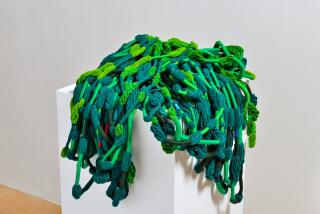AROUND HOME : Batik
- Share via
ANYONE WHO LIVED through the ‘60s probably had a batik bedspread, wall hanging or caftan. Like tie-dying and love beads, it was an art uniquely associated with those free-spirited days. But then, like so many of the skills of that crafts revolution, batik languished, only recently enjoying a small renaissance among serious fiber artists.
Batik is an ancient art, going back to Egypt, Persia, China, Japan and India, but it reached its full potential on the small island of Java. Since the 10th Century, Javanese batik has been the art of kings and then commoners, and special patterns were developed to cover most important occasions, such as weddings. One design is believed to have curative powers; another is used to wrap a newborn baby.
The Javanese patterns are exquisite and complicated repetitive designs, an ideal to which most of us can only aspire. On a more practical, at-home level, batik is quite simple, requiring only paraffin or beeswax, fabric and dye. Paraffin and dye are available at supermarkets, and any natural-fiber fabric will do (polyesters do not take dyes, but some nylons and ramies do; if there is any doubt about fiber content, dye a small sample before embarking on a major project). Simply make designs on the fabric, using objects dipped in wax (such as tin cans, needles or brushes); the wax will remain on the fabric. An even simpler method is to dribble wax onto the fabric. Once the wax design is complete, the fabric is dyed--but those waxed areas will not be colored. This is called a “resist” technique because the waxed portions resist or repel the dye. When the fabric is dry, the wax is removed, usually by running a hot dry iron over a piece of paper placed over the fabric. More advanced practitioners will wax and dye the fabric several times, ending with a multicolored extravaganza that might even get a second look in Java.
Supplies can be found at most art stores, at Aaron Bros. throughout Southern California and Kit Kraft in Studio City. Most libraries carry books (usually from the ‘70s) on batik.
More to Read
Sign up for The Wild
We’ll help you find the best places to hike, bike and run, as well as the perfect silent spots for meditation and yoga.
You may occasionally receive promotional content from the Los Angeles Times.






